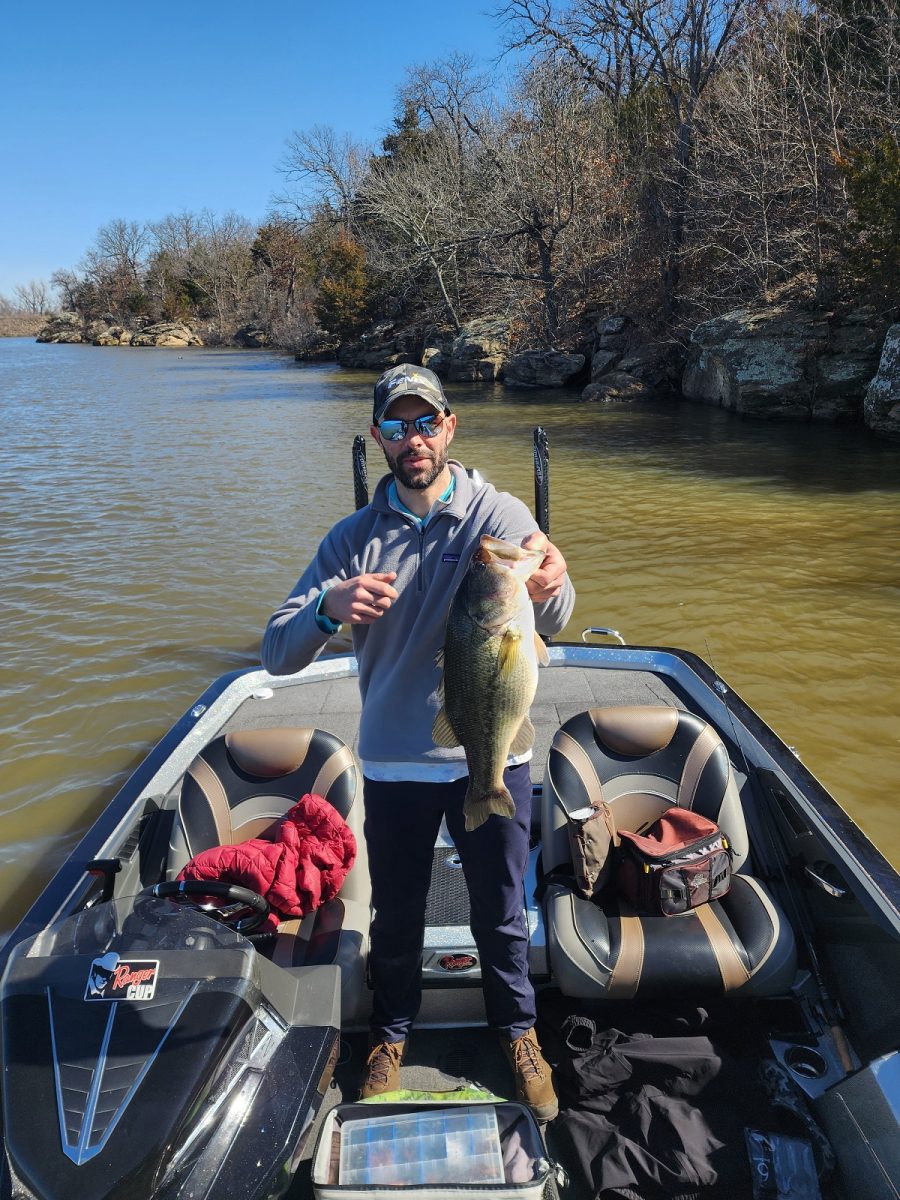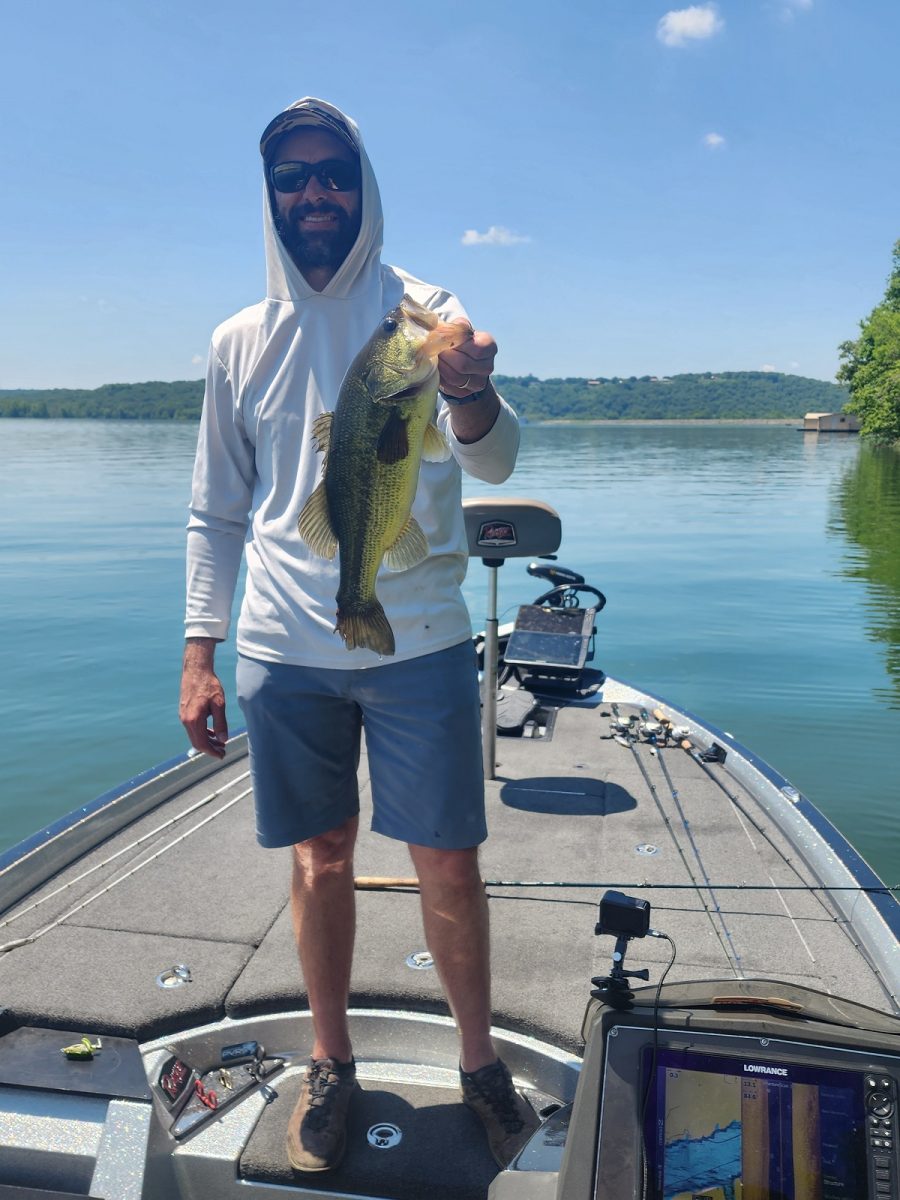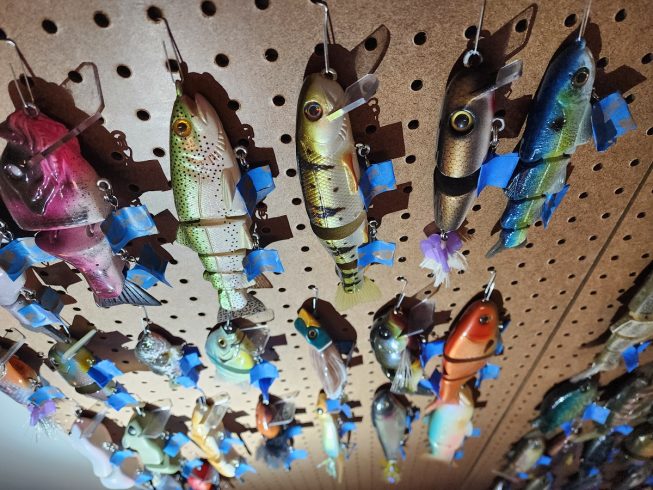What is a Swimbait?
A swimbait is a type of fishing lure designed to imitate the swimming action of baitfish. Swimbaits are typically larger than standard lures and are used to attract bigger predatory fish such as bass, pike, and muskie. The lifelike appearance and movement of swimbaits make them highly effective for enticing fish to strike, especially in waters where natural prey is abundant. Swimbaits can be made from a variety of materials, including plastic, rubber, and even wood, and they come in various designs that mimic different types of forage fish.
You can find custom designed and painted swimbaits of all types. A lot of these baits are hand-made pieces of art!
What are the Different Types of Freshwater Swimbaits?

There are several types of freshwater swimbaits, each designed for specific fishing conditions and target species:
- Soft Plastic Swimbaits: These are flexible and often infused with scent to attract fish. They come in various sizes and can be rigged in multiple ways, including Texas rig, Carolina rig, or on a jighead. These are smaller in size most of the time compared to the hard body swimbaits.
- Hard Body Swimbaits: Made from hard plastic or wood, these swimbaits are durable and often feature multiple jointed segments to create a realistic swimming action. They are typically more expensive than soft plastics but offer a more lifelike appearance.
- Paddle Tail Swimbaits: Characterized by their paddle-shaped tail, these swimbaits produce a distinctive wobbling action in the water, making them highly effective at mimicking injured prey.
- Glide Baits: These are a type of hard body swimbait designed to glide side-to-side in a wide, sweeping motion. They are particularly effective for targeting large, wary fish. This is my favorite type of swimbait to fish for largemouth bass in Oklahoma/Texas.
- Realistic Swimbaits: These are highly detailed lures that closely resemble specific species of baitfish. They are often used in clear water conditions where fish can scrutinize their prey closely.

How to Rig a Swimbait?
Rigging a swimbait properly is crucial to its effectiveness. This mainly applies to soft swimbaits, since hard swimbaits do not require rigging. How you rig it can make the difference between catching fish and catching nothing. Here are a few common methods:
- Weedless Rig: For fishing in heavy cover, use a wide-gap hook and rig the swimbait weedless by inserting the hook into the nose of the bait and threading it through the body so the hook point is buried just under the surface of the plastic. This reduces snagging on vegetation.
- Jighead Rig: This method involves threading the swimbait onto a jighead, which provides weight and stability. Insert the jighead hook through the nose of the bait and push it through until the bait sits snugly against the jighead.
- Line Through Rig: This technique is popular for larger swimbaits. The fishing line is threaded through a channel in the bait and tied to a treble hook that hangs freely beneath. This setup allows for better hook-ups and prevents fish from using the lure as leverage to escape.
- Texas Rig: Similar to the weedless rig but with a bullet weight added above the hook. This rig is versatile and works well in both open water and cover.

How to Fish a Swimbait?
Fishing a swimbait effectively requires understanding the behavior of the fish you are targeting. I mostly fish for largemouth bass, so these may differ across fish species, such as musky or pike.
- Slow and Steady Retrieve: A consistent, slow retrieve often works best, allowing the swimbait to exhibit its natural swimming action. This method is particularly effective for bass. I love fishing a slow and steady retrieve using a glide bait…which mimics a bait fish that is injured or stunned, which result in some really exciting action!
- Pulsing Retrieve: Vary the speed of your retrieve to mimic the erratic movement of an injured fish. This can trigger reaction strikes from predatory fish.
- Pausing: Periodically pause your retrieve to let the swimbait fall, mimicking a dying fish. This can be especially effective when fishing for wary or pressured fish.
- Bottom Bouncing: Let the swimbait sink to the bottom and retrieve it in a hopping motion. This is effective for species like walleye that often feed near the bottom.
- Cover and Structure: Cast near structures like rocks, weed beds, and submerged logs where predatory fish are likely to ambush prey. Make sure to work the swimbait close to these features.

Where to Buy a Swimbait?
Swimbaits can be purchased from various retailers, including:
- Online Retailers: Websites like Swimbaits.com, Tackle Warehouse, Amazon, and eBay provide a vast array of swimbaits with the convenience of home delivery.
- Local Tackle Shops: These stores often have knowledgeable staff who can provide advice on the best swimbaits for local waters.
- Outdoor Sporting Goods Stores: Large chains such as Bass Pro Shops, Cabela’s, and Dick’s Sporting Goods offer a wide selection of swimbaits.
- Fishing Expos and Shows: Attending fishing expos can be a great way to see new products and get expert advice directly from manufacturers.
- Facebook Groups: Lots of people are buying and selling through facebook groups or forums, however, beware of scammers that demand you pay via “friends and family”, in which you are not protected from scammers!
You can expect a wide range of pricing for swimbaits. Even if a bait looks really good, it may only cost $20…or you may find a hand-made lure that doesn’t look like much, that will run you $150!
Online Resources for Swimbaits
The internet offers numerous resources for learning about and purchasing swimbaits:
- Fishing Forums: Websites like BassResource and TackleTour have active forums where anglers share tips and experiences with different swimbaits. You can also check out Swimbait Underground and Swimbait Universe.
- YouTube: Channels like TacticalBassin and Flukemaster offer in-depth videos on selecting, rigging, and fishing swimbaits.
- Manufacturer Websites: Companies like Megabass, Huddleston, and Keitech provide detailed information on their products and how to use them.
- Social Media: Instagram and Facebook groups focused on fishing are great places to find community advice and see swimbaits in action. Check out Swimbaitvandals on Instagram.

What Gear You Need to Fish with Big Swimbaits
Fishing with big swimbaits requires specialized gear to handle the size and weight of the lures:
- Rod: A heavy or extra-heavy rod with a fast action tip is ideal for casting large swimbaits and setting the hook effectively. Look for rods specifically designed for swimbait fishing. My favorite are Leviathan Rods.
- Reel: A high-capacity baitcasting reel with a strong drag system is necessary to manage the weight of the lure and the power of large fish. Gear ratios in the range of 6.3:1 to 7.1:1 are common. Here is one of my favorite reels : Shimano Tranx 300.
- Line: Use a strong, abrasion-resistant line. Braided line with a fluorocarbon leader is a popular choice. Line strength should be at least 20-30 lb test for larger swimbaits.
- Hooks and Terminal Tackle: Ensure you have high-quality, sharp hooks that match the size of your swimbait. Swivels, split rings, and other terminal tackle should also be robust.
- Storage: Larger swimbaits require ample storage space. Invest in a tackle box or bag that can accommodate the size and shape of these lures.
Fishing with swimbaits can be incredibly rewarding, offering the chance to catch trophy-sized fish. By understanding the different types of swimbaits, how to rig and fish them, and where to buy them, anglers can significantly improve their chances of success on the water.

